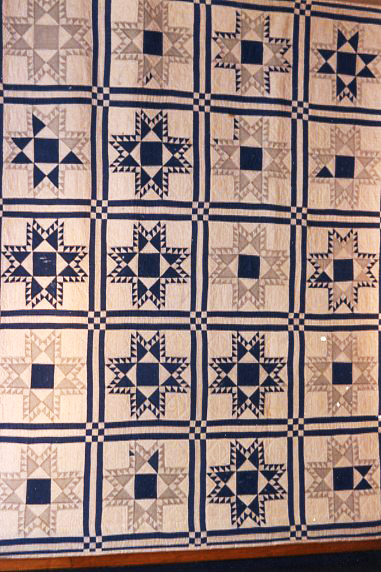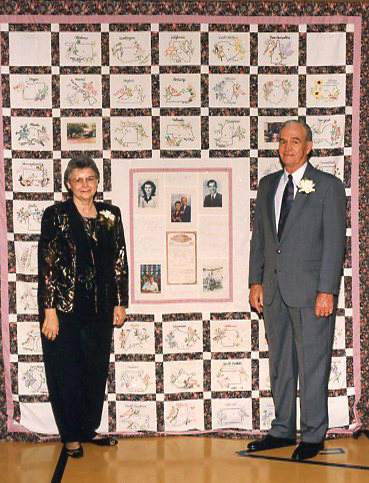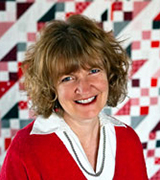Note: This continuing series reposts some of the most memorable columns of Suzy’s Fancy, which ran from 2009-2020. This piece originally ran in November 2013.
A leitmotif is a term that refers to a recurring theme, usually relating to a musical composition, but by extension to literature, film, or as a metaphor for the life of a character or person. In the case of well-known quilter Kathleen McCrady and her husband, Jack, who celebrated their 70th wedding anniversary on Christmas Eve last year, the leitmotif of their life together would be quilts.

“The ‘copen blue’ fabric was purchased by mail order from Montgomery Ward. It was either purchased in a small amount or was left over from clothing before WWII, and there was not enough to complete the quilt. During the war years, textile plants ceased manufacturing for the home front and turned to government contracts for war products. Many plant employees were drafted into the service and consumer products were not plentiful. It was not until the war was over that more copen blue fabric was ordered from the same company. At that time the blues were all the same color, but with years of use and washing, evidence of the changes in the manufacturing process showed up. The faded light blue that you see is pre-WWII, and the brighter blue is post-WWII.”
Kathleen and Jack were high school sweethearts, but they became acquainted around the time they were in the sixth grade. They both grew up in Gould, Oklahoma, a tiny rural community in the southwestern corner of that state.
Both came from farming families, and both were raised to work hard helping their parents make a living, as was common during the Great Depression. Jack’s grandmother lived with his family, and his grandmother, mother, and aunts pieced and quilted together.
As a child, Jack played under the quilt frame while the women quilted. Kathleen also came from a long line of quilters, who taught her to quilt when she was six years old. Quilts were how their families kept warm, and quilting was an everyday part of their lives.
They married during their Christmas break when they were both seniors in high school. Jack drove a school bus (can you imagine a high school senior being allowed to do that today?) and farmed cotton while still going to school. And after they married, they lived with his family. Jack’s aunt Grace gave the newlyweds a quilt top as a wedding present.
Kathleen and Jack both finished high school, graduating in May of 1943. Jack was drafted into the Army one month later, serving for the duration of World War II in the Army Air Corp as a pilot flying a variety of twin-engine aircraft.
During the war years, Kathleen was able to follow Jack to many of the places where he was stationed, but their nomadic military lifestyle and demands of young motherhood meant that for the first time in her life, Kathleen took a temporary break from quilting. It didn’t last long though. After the war was over, Jack’s mother and grandmother gave the young couple a Feathered Star top when they moved into their first home in 1946. Kathleen quilted it in 1948 and it served as their bedspread.

When the couple finally settled down with their four children in Austin, Texas, where Jack worked for the Texas National Guard, Kathleen began making quilts of her own.
“It was not until after I had sewed for kids and had a scrapbag that I really started to piece quilts,” Kathleen recalls. “In the ‘50s after we moved to Austin, Jack’s parents came and stayed with us for about three weeks. We put up a quilting frame and his mother and I quilted tops I’d made for our beds.”
During the 1950s and ‘60s, even after the children were all in school and she began working outside the home, Kathleen never stopped quilting. She considered herself to be a “closet quilter” because outside of her family, she didn’t know anyone else who quilted.
“In fact, quilting was taboo in the community at that time,” Kathleen says. “Most homemakers bought blankets for their beds, so I shared little about the fact that I made quilts.”
As Kathleen eagerly embraced the quilting revival of the 1970s, and as she developed her skills and knowledge in the ensuing decades to the point of becoming a recognized master of the art, Jack’s support of her quilting never waivered.
When she needed a studio to work in, Jack created a space in their home. When her quilts were first featured in a one-woman show, it was Jack who helped hang them. And when she began to teach and lecture about quilting, it was Jack who helped her pack her supplies and who often acted as her driver.
Invariably, their family vacations began to include visits to quilt museums or areas known for quilting so that Kathleen could expand her knowledge even further, and Jack was always by her side. When she received awards for her quilts, Jack was her biggest fan.
When she eventually donated her extensive collection of quilts and quilt-related ephemera to the Dolph Briscoe Center for American History at the University of Texas at Austin, Jack was a full partner in the decision to do so. As she made quilts for each of their 11 grandchildren, 18 great-grandchildren, and four great-great-grandchildren, Jack shared in her family pride.
Quilts are a recurring theme throughout both Kathleen and Jack’s lives as individuals, and they are also a recurring theme in the couple’s life together. It is said that a leitmotif can help a composer relate a story without the use of words or add an extra level of meaning to an already-present story. In the case of the story of Kathleen and Jack McCrady, quilts add that extra level of meaning—and it is all about love.



